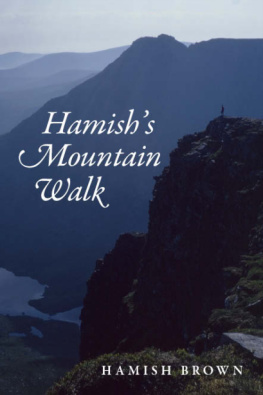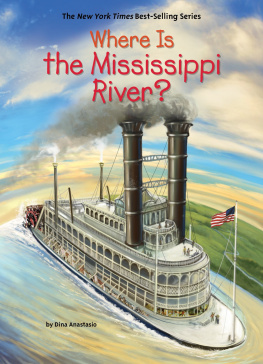Ghosts along the Mississippi River
GHOSTS
along the Mississippi River
ALAN BROWN

www.upress.state.ms.us
The University Press of Mississippi is a member of the Association of American University Presses.
Copyright 2011 by University Press of Mississippi
All rights reserved
Manufactured in the United States of America
First printing 2011
Library of Congress Cataloging-in-Publication Data
Brown, Alan, 1950 Jan. 12
Ghosts along the Mississippi River / Alan Brown.
p. cm.
Includes bibliographical references and index.
ISBN 978-1-61703-143-4 (cloth : alk. paper) ISBN 978-1-61703-144-1 (pbk. : alk. paper) ISBN 978-1-61703-145-8 (ebook) 1. GhostsMississippi River Region. I. Title.
BF1472.U6B742 2011
133.10977dc22
2011007985
British Library Cataloging-in-Publication Data available
To my wife, Marilyn, who gave me the idea for this book and accompanied me to many of these haunted places
Contents
The Father of Waters: The Mississippi River
Acknowledgments
I would like to thank Patti Pointer, Shirley Smollen, Michael Espanjer, and Lisa Marks for telling me their stories. As always, I am beholden to author Troy Taylor for the support he has given me over the years with my various projects. I am also indebted to the following ghost tours for helping me pinpoint each citys haunted sites: Haunted Ghost Walking Tour of Memphis, Annie Wiggins Ghost Tour of Galena, the History and Hauntings Ghost Tours of Alton, Vicksburg Historical Ghost Tours, Natchez Ghost Tours, New Orleans Ghost Tours, and Garden District Tours. Finally, I would like to thank the University of West Alabamas University Research Committee for providing me with the funding for my trips to these haunted cities.
Ghosts along the Mississippi River
Introduction
THE FATHER OF WATERS: THE MISSISSIPPI RIVER
The Mississippi River is, and always has been, the most important river in the United States. Second only to the Missouri River in length, the Mississippis drainage area covers 40 percent of the United States and forms the third-largest drainage basin in the world. From its beginnings in Minnesota, the Mississippi flows south along the borders of Wisconsin, Illinois, Kentucky, Tennessee, and Mississippi on the east and Minnesota, Iowa, Missouri, Arkansas, and Louisiana on the west. Its most important tributaries between Minneapolis and St. Louis are the Illinois, Chippewa, Black, Wisconsin, Saint Croix, Iowa, Des Moines, and Rock Rivers. The Ohio River feeds into the Mississippi River at Cairo, Illinois. By the time the river has completed its course down to New Orleans and the Gulf of Mexico, it has covered 2,348 miles.
A Spanish explorer named Hernando De Soto was the first white man to cast his eyes on the body of water the Indians called The Father of Waters in 1541. In their search for a water passage to China more than a hundred years later, Jacques Marquette and Louis Joliet traveled down the Wisconsin River to the point where it connects with the Mississippi, south of Prairie du Chien in 1673. When the pair reached the point where the Arkansas River and the Mississippi River join, they realized that the river would not take them to China, and they headed back. In 1679, LaSalle and his friend, Henri de Tonty, traveled down the Illinois River by canoe and made their way to the Mississippi. Father Hennepin went to St. Anthony Falls, and LaSalle traveled down river to the Gulf of Mexico. In 1782, LaSalle arrived at the mouth of the Mississippi River and claimed the entire Mississippi Valley for France, which ceded the region to Spain in 1763 but reclaimed it in 1800. Three years later, the United States acquired the Mississippi River as part of the Louisiana Purchase.
The Mississippi River was used as a means of travel and transportation long before the arrival of the white explorers. The Indian tribes that Lewis and Clark encountered when they passed through the Mississippi Valley in 1803the Winnebago, the Fox, the Ojibway, the Sauk, the Chickasaw, the Choctaw, the Natchez, and the Alabamahad traveled up and down the river in canoes. The French fur traders navigated the river in crude bull boats. The early settlers used flatboats and keelboats to reach their destinations. The first paddle-wheel steamboatthe New Orleansbegan chugging up and down the Ohio and Mississippi Rivers in 1811. In 1823, the Virginia became the first steamboat to travel the upper Mississippi River. Steamboat traffic on the Mississippi was temporarily halted during the Civil War. However, in 1863, the Mississippi River was used as an invasion route for the Union army after the capture of Vicksburg. After the Civil War, steamboats once again plied the Mississippi River, but they faced increased competition from the railroads. Still, by 1800, 4,800 steamboats were carrying passengers and freight on the Mississippi. Navigation on the Mississippi River improved greatly in the late 1800s and early 1900s as a result of the changes made by the army engineers, who removed the snags, dynamited boulders out of the channels, and built a series of dams. The lock-and-dam system in the upper Mississippi River authorized by Congress in the 1930s made possible the transportation of commodities like grain, petroleum, fertilizer, rock salt, and anhydrous ammonia.
Before the Civil War, most of the workers who loaded the boats and did the heavy work on board were Irishmen and Germans. After the Civil War, many of these jobs were taken over by newly freed slaves. Working on the river was often tedious and mind-numbing, so to pass the time, river men amused themselves by drinking, gambling, wenching, and spinning yarns. They talked about her-girls, mermaid-like creatures who dragged a Greenville black man named Big Black down to the bottom of the river. On dark, cold nights, the workers frightened one another with tales of a black deckhand named Chattanooga who drowned in the Mississippi but whose ghost returned each night to take a cigar out of the icebox, light it, and blow smoke rings. White river men spoke of Sal Fink, the daughter of famed keelboat man Mike Fink, who snapped off all of the snags on the river and rode on the back of an alligator.
The Mississippi River has also inspired a number of well-known American authors. The first was Herman Melville, whose 1857 novel The Confidence Man is a savage indictment of the greed and commercialism of the mid-nineteenth century. The author who is most associated with the Mississippi is Mark Twain, who finally achieved his lifelong dream of becoming a steamboat pilot in 1860. In his book Life on the Mississippi, Twain described the river as an implacable force of nature that could never be tamed. F. Scott Fitzgerald, who was born in St. Paul, Minnesota, wrote of the gulf separating the affluent urban dwellers and the poor who lived along the river. T. S. Eliot, who spent his formative years in St. Louis, credited the Mississippi River as having a tremendous influence on his poetry. In The Negro Speaks of Rivers, black poet Langston Hughes wrote of Abraham Lincolns life-changing trip down the Mississippi River to the slave markets in New Orleans.
Literary expressions of the Mississippi River will always hold a special place in the imagination of American readers. Ironically, in recent years, many people have become fascinated with the rivers oral narratives, especially those tales that deal with its link with the supernatural. Haunted buildings like the Lemp Mansion in St. Louis, Missouri, and the Mineral Springs Hotel in Alton, Illinois, are regularly featured in television shows like
Next page













